Introduction
A SWOT analysis, an acronym for strengths, weaknesses, opportunities, and threats, is a powerful tool for strategic planning in businesses of all sizes. It provides a comprehensive assessment of both internal and external factors that can impact an organization's operational effectiveness and strategic goals. By identifying strengths, weaknesses, opportunities, and threats, businesses can make informed decisions and develop strategies that leverage their strengths, address their weaknesses, seize opportunities, and mitigate threats.
In this article, we will explore the components of a SWOT analysis, practical examples of its application, and best practices for conducting an effective analysis. Whether you're a CFO looking to navigate the complexities of today's business landscape or a business strategist seeking practical advice, this article will equip you with the knowledge and tools to harness the power of SWOT analysis and drive success for your organization.
What is SWOT Analysis?
A SWOT analysis, an acronym for strengths, weaknesses, opportunities, and threats, serves as a cornerstone of strategic planning, assisting businesses of all sizes to chart a course through both calm and turbulent waters in their industry. This analytical framework is designed to facilitate a clear-eyed assessment of the factors that can have a profound impact on an organization's operational effectiveness and strategic goals.
At its core, SWOT analysis is about introspection and anticipation. It pivots on the identification of an organization's internal strengths, such as its standout qualities and unique competencies - which could range from a highly skilled workforce, robust financial standing, to cutting-edge technology. Conversely, weaknesses are internal factors that might hinder performance or growth, necessitating management's attention to devise compensatory strategies.
Moving beyond the internal landscape, the analysis also scans the horizon for external opportunities that can be harnessed to propel the business forward, as well as threats that loom, which could include market volatility, competitive pressures, or shifts in regulatory landscapes. It is through this dual lens of internal capacities and external possibilities that SWOT analysis earns its stripes, empowering organizations to align their resources and capabilities with the external environment.
The utility of SWOT analysis is not confined to evaluating the current state of affairs; it also primes an organization to pivot or adapt its strategies. For instance, by leveraging strengths to seize emerging opportunities or by buttressing areas of weakness to ward against potential threats. In this way, SWOT analysis is not just a static report card but a dynamic playbook for navigating the future.
The insights gleaned from a SWOT analysis are invaluable, serving as the bedrock upon which strategies are crafted, ensuring they are both grounded in reality and attuned to the aspirations of the business. Whether employed to assess the viability of a new project or to recalibrate an organization's overall direction, SWOT analysis remains an indispensable tool in the business strategist's arsenal.
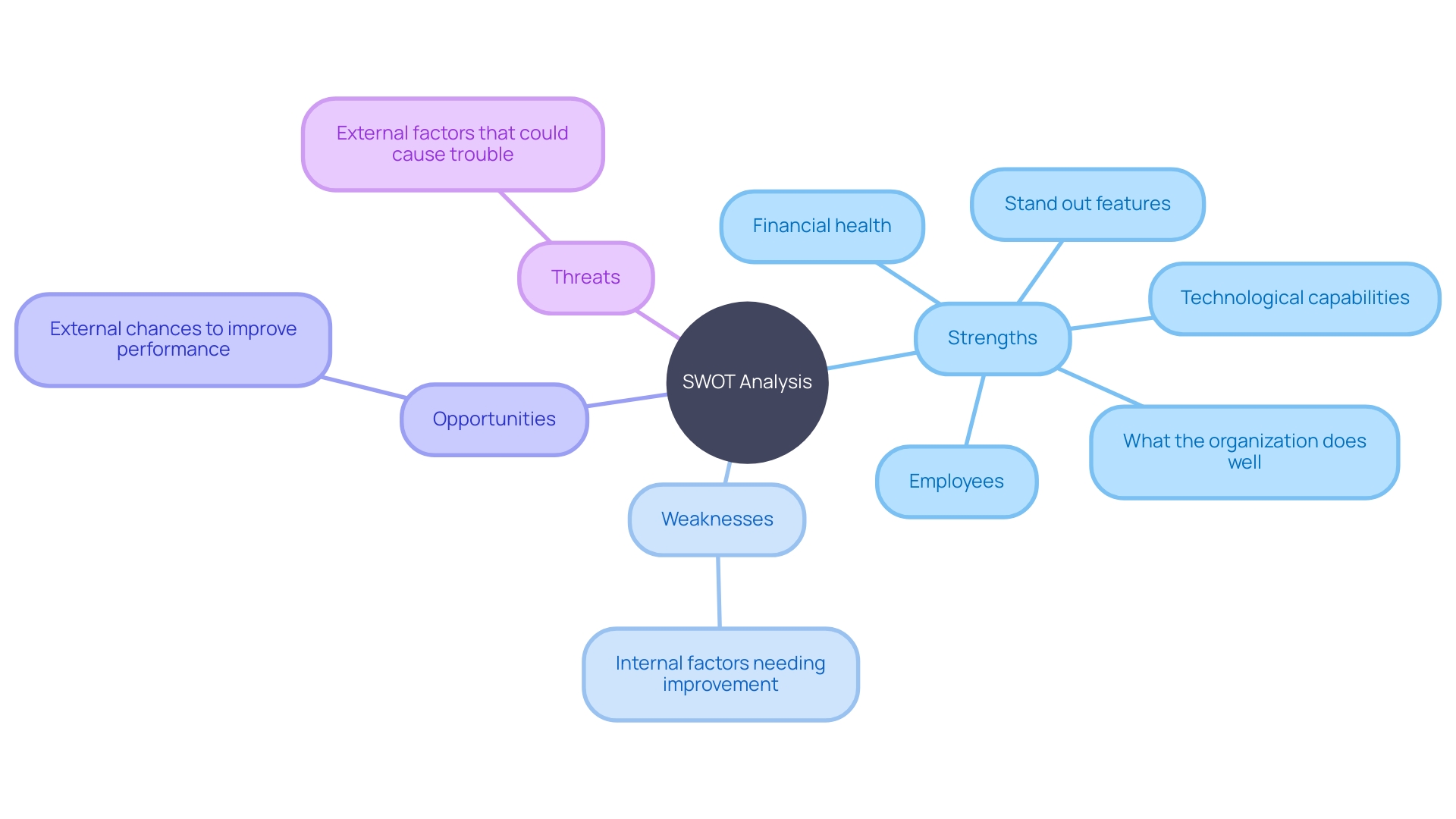
Components of SWOT Analysis
A SWOT analysis is a comprehensive framework employed by businesses to scrutinize their competitive stance and plot strategic directions. It encompasses the evaluation of strengths, weaknesses, opportunities, and threats. Strengths are the unique qualities that give an organization its competitive edge, such as skilled personnel, robust financial health, or advanced technological infrastructure.
Weaknesses, on the other hand, are areas that require improvement or present obstacles that the company must navigate. Opportunities are external chances for growth or enhanced performance, while threats include external challenges that could impede success.
Conducting regular SWOT analyses offers businesses, regardless of size or stage, the clarity needed to reassess their current business state, anticipate future paths, and make informed decisions. It’s a step back to gain a panoramic view of the company's operational health and the dynamic market landscape. Such strategic evaluations are critical for crafting strategies to leverage strengths, mitigate weaknesses, adapt to the business environment, and seize available opportunities while guarding against potential threats.
In practice, a SWOT analysis can lead to actionable insights. For example, a business may identify its innovative R&D department as a strength and use this to differentiate its products in a crowded market. Simultaneously, it might pinpoint a reliance on a single supplier as a weakness and develop a more diverse sourcing strategy to reduce risk.
For opportunities, a business might notice a growing demand in an emerging market and plan to expand its operations there. Conversely, the threat of new regulations might prompt the formation of a compliance strategy to navigate future challenges.
In essence, SWOT analysis serves as a strategic compass, guiding businesses through the complexity of today's fast-paced environment by highlighting the internal and external factors that are crucial to maintaining a competitive advantage.
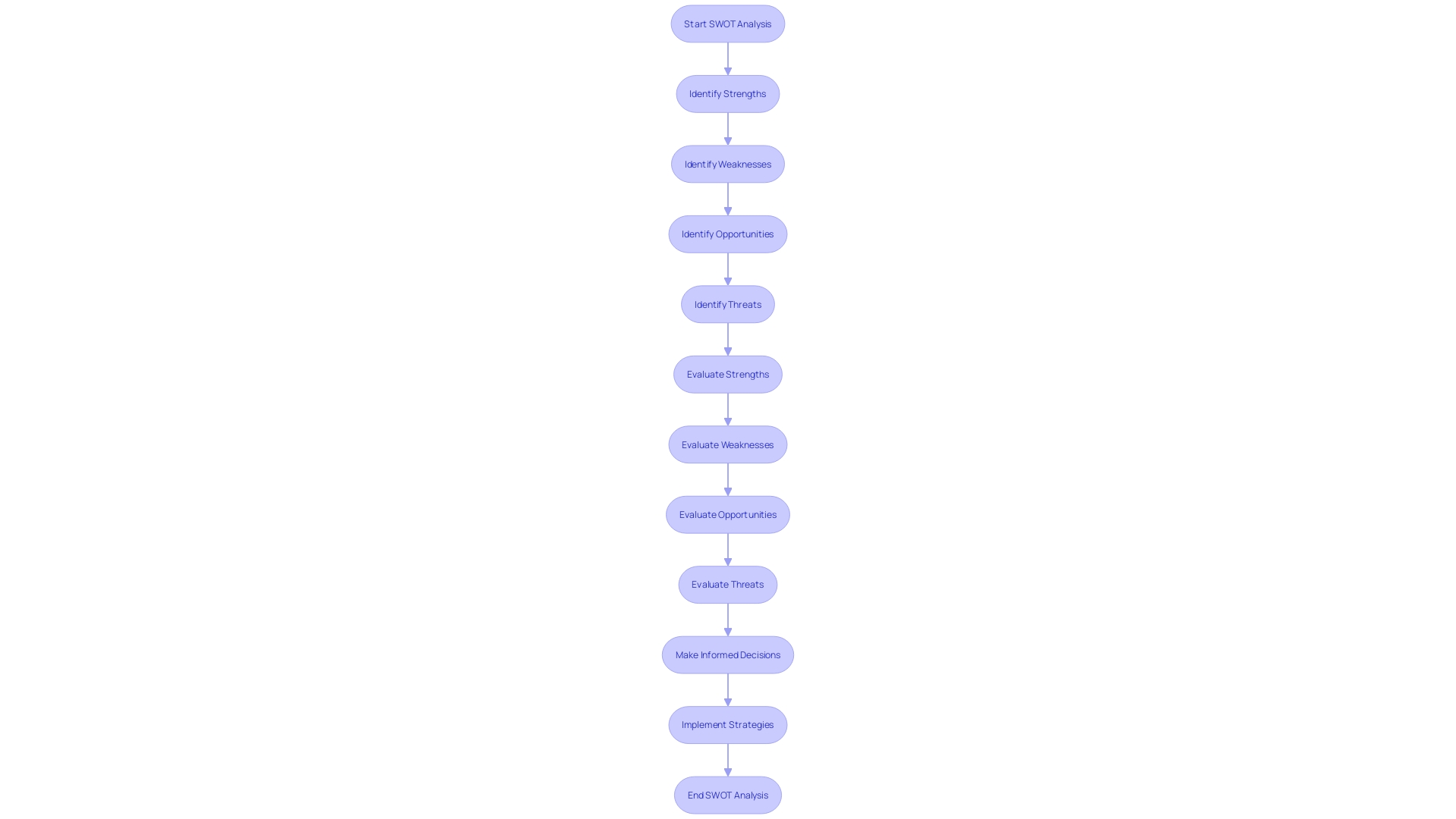
Strengths: Identifying Internal Advantages
Understanding a company's strengths is paramount for leveraging competitive advantages and fostering business growth. These internal factors are strategic assets that set a company apart from the competition. A thorough analysis of these strengths involves a multifaceted approach, considering various elements that contribute to a company's success.
For instance, intellectual property such as patents, trade secrets, and unique methodologies are invaluable assets that can ensure a company remains at the forefront of innovation. Additionally, having robust data - both internal and external - can provide insights for strategic decision-making and help maintain a competitive edge.
Strong sales and distribution networks are crucial for delivering products and services effectively, while a well-established brand can enhance customer loyalty and trust. A sound financial position, characterized by healthy cash flows, supports not only day-to-day operations but also long-term investment opportunities.
A culture that fosters innovation is another significant strength, encouraging continuous improvement and adaptation in a rapidly changing market. Strategic partnerships with other companies, universities, community groups, and government agencies can offer support, resources, and invaluable networking opportunities.
Lastly, possessing the requisite technology to meet current and future demands is essential. As we navigate through economic fluctuations, companies with a growth mindset, those that actively choose and resource growth despite uncertain times, are the ones that thrive.
In the pursuit of business excellence, it is critical to identify and capitalize on these strategic assets. By doing so, companies can effectively navigate market changes, harness growth paths like optimizing sales and penetrating customer bases, and ultimately deliver an outstanding customer experience that stands the test of time.
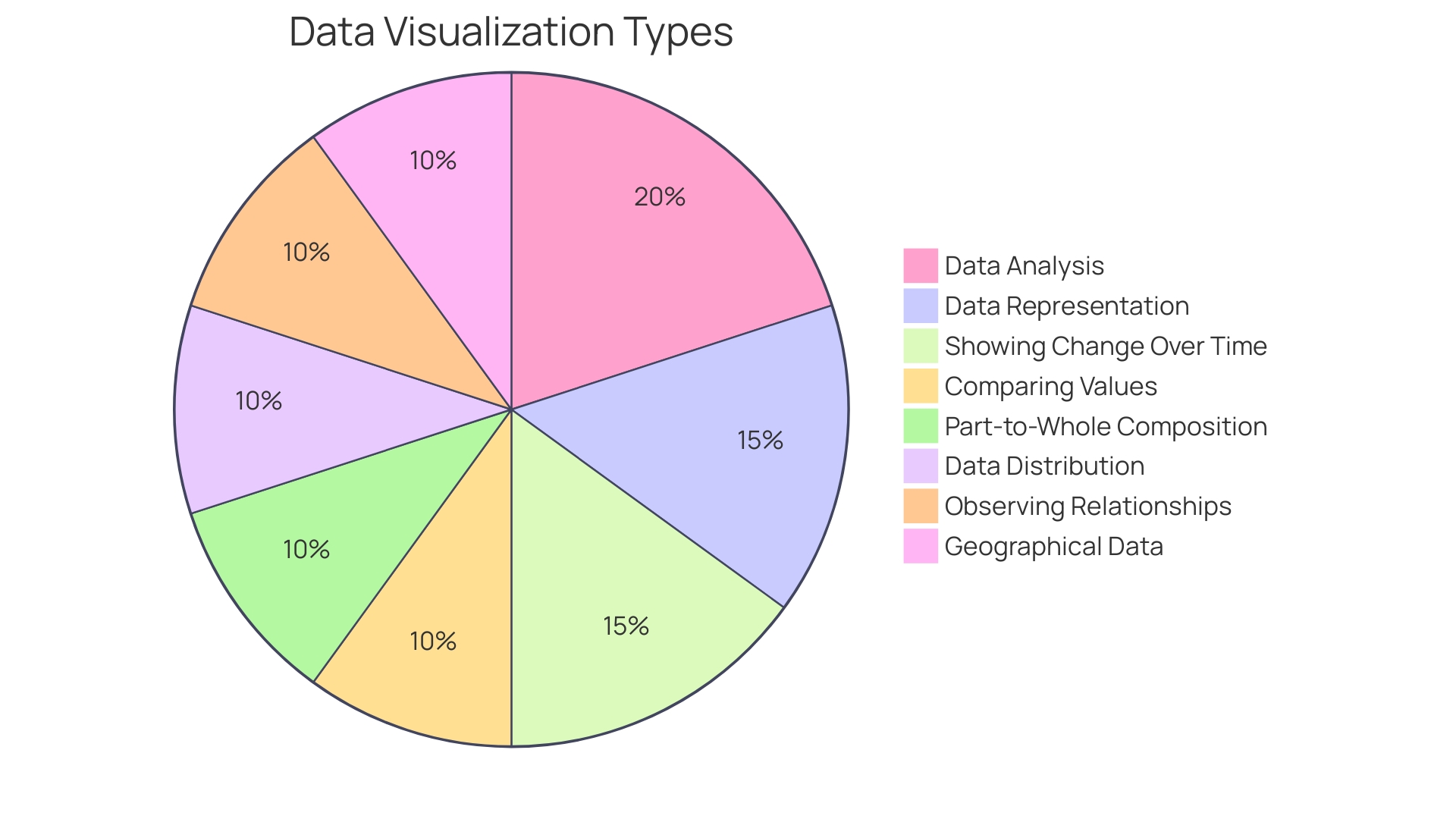
Weaknesses: Understanding Internal Challenges
A company's weaknesses are those internal elements that can hinder performance and growth. Understanding these weaknesses is a prelude to developing a robust strategy to address them. Recognizing this, some organizations have taken innovative approaches to foster a culture that turns potential weaknesses into strengths.
For instance, Latro Kimya, a Turkish industrial chemicals company, eschews traditional hierarchical structures for a self-managed, transparent, and learning-oriented environment. This approach can transform potential internal communication weaknesses into collaborative strengths.
Innovation leaders, like Microsoft, have demonstrated the importance of proactive measures in nurturing innovation—a potential weakness if left to chance. They've implemented systems to capture and refine innovative ideas, turning potential operational weaknesses into competitive advantages.
Moreover, decisive leadership, as indicated by OHI research, has emerged as a pivotal factor in organizational health, particularly during turbulent times. The ability to make quick decisions and commit to them can be a decisive factor in overcoming internal challenges.
Carrying out an internal analysis is critical. It allows a company to dissect its operational framework, identifying performance drivers and growth inhibitors. This analysis serves as a decision-making aid, enabling leaders to optimize strategies that resonate with the company's realities.
The key to a robust strategy is not just setting goals but addressing the most significant challenges. Focusing on outputs alone, such as automated processes, is less effective than solving core issues that enable faster product iterations and value delivery to customers.
Remember, it's not about listing all problems but prioritizing and tackling those that impede progress. A company's journey through growth stages will inevitably face crises, but resilience building enables continued growth and development.
To encapsulate, addressing weaknesses is not about avoiding risks but about strategically analyzing opportunities, like launching a new product line or entering a new market, and calculating their ROI. This strategic approach, coupled with a culture of innovation and decisive leadership, can transform weaknesses into engines of growth.
Opportunities: Leveraging External Factors
Opportunities in the market are like hidden treasures waiting to be discovered and utilized for business growth. For a company operating globally, with over 300 companies in more than 23 countries and employing upwards of 26,000 individuals across diverse industries, identifying these chances can be crucial. Embracing a culture of entrepreneurship and innovation, such as IBL has done, positions a business to not only survive but thrive amid market fluctuations, including those spurred by the COVID-19 pandemic or conflicts.
Strategic Solution Partners has carved a niche in the hospitality industry as a go-to for revenue management and operational solutions. By tailoring their services to the unique needs of each client, they have proven that understanding client requirements and market dynamics plays a pivotal role in seizing opportunities.
Consider the hotel company that significantly boosted bookings after a strategic overhaul of their online advertising, incorporating tools like Google Analytics and Facebook Pixel. A detailed keyword investigation for their PPC campaigns was the game-changer they needed, showcasing how a well-crafted strategy can turn potential into profit.
Rhonda Gibler from Carenet Health emphasizes the importance of capitalizing on changes, including the global shift back to in-person meetings, to establish trust and forge long-lasting business relationships. Identifying clients with needs that align perfectly with a company's strengths can create a lucrative target market.
Moreover, strategic partnerships, as mentioned by industry experts, can lead to shared costs, common distribution channels, and accelerated growth. Such collaborations allow companies to leverage their unique strengths while benefiting from economies of scale.
In summary, opportunities abound for those who are prepared. By staying informed on market trends, utilizing strategic partnerships, and being ready to adapt, businesses can turn external market conditions into stepping stones for success. The key is to have a clear understanding of one's strengths and the agility to pivot strategies as the market evolves.
Threats: Addressing External Risks
External threats can pose significant challenges to a company's operations and can come from a multitude of sources. For instance, utilities in California have faced the escalating risk of catastrophic wildfires, with the past two decades seeing a rapid increase in such events. These risks are often compounded by uncertainties in risk levels, sources of risk, and the unclear cost and effectiveness of mitigation strategies.
As companies like utilities have shown, safety measures to protect against these threats can lead to economic trade-offs, such as higher electricity rates, and carry reputational risks, especially when they are widely discussed in media and political circles.
When it comes to addressing threats, it's crucial for businesses to prioritize the protection of their most valuable assets. These can range from tangible assets like buildings and equipment to intangible assets such as proprietary software, brand reputation, and organizational know-how. The first step in bolstering security is identifying the critical assets that are essential to the success of the business.
It's then important to integrate a robust security culture from the startup phase, where security incidents are openly discussed and learned from. This proactive approach to security not only helps in mitigating risks but also enhances a company's appeal to customers and investors.
Furthermore, it's essential to recognize that threats can arise from various points, whether it's at your premises, from employees, visitors, or external parties, or even during travel when assets, information, or data may be exposed. A comprehensive risk assessment is the starting point for any business continuity and crisis management plan. This involves multiple stakeholders from across the organization, including human resources, legal, IT, and finance, to ensure a well-rounded approach to risk management.
Such plans should cover all potential impacts, encompassing people, facilities, legal obligations, finances, and reputation.
In today's digital age, technology plays a pivotal role in managing security and providing value through innovative solutions. Security-as-a-Service, for example, is transforming expectations of security operations, allowing organizations to cover more ground and deliver excellence in service. As the landscape of threats continues to evolve, businesses must stay informed and agile, using reliable data, ignoring biases, and seeking expert advice to navigate the complexities of risk management effectively.
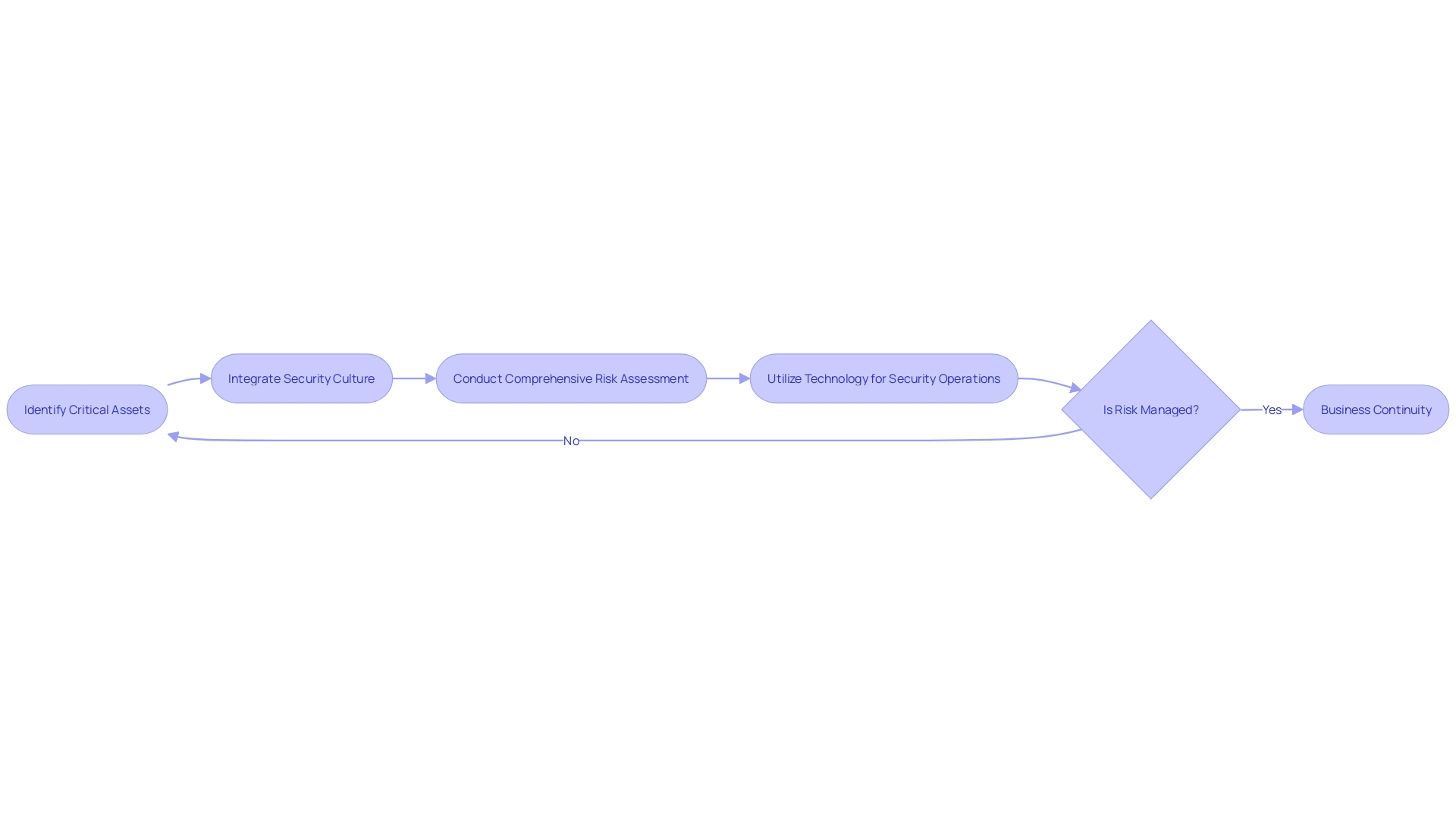
How to Conduct a SWOT Analysis
Conducting a SWOT Analysis is a critical exercise for businesses to assess their competitive position and develop strategic plans. A SWOT Analysis delves into the internal strengths and weaknesses of an organization, as well as the external opportunities and threats in the industry. Strengths may include unique resources, skilled personnel, or a strong financial foundation, whereas weaknesses might be areas like limited technology or resource constraints.
To effectively execute a SWOT Analysis, businesses must first collect and scrutinize relevant data. A comprehensive understanding of the business environment is essential, which includes recognizing potential regulatory changes or competitive pressures that could arise as threats. Subsequently, documenting the findings in a structured manner provides a visual representation that facilitates strategic discussions.
This approach not only improves communication and collaboration across various departments but also enables informed decision-making.
Particularly for startups, a SWOT Analysis is invaluable. It offers a macro view, aiding in strategy formulation and aligning business objectives with market realities. By identifying strengths and weaknesses, organizations can make strategic use of their resources.
Additionally, the analysis highlights opportunities for growth and innovation, while also flagging threats that may require risk mitigation strategies. Ultimately, the aim is to use the insights from the SWOT Analysis to reinforce the business's foundation and guide its trajectory towards success.

Step-by-Step Guide to Creating a SWOT Matrix
Creating a SWOT Matrix offers a comprehensive snapshot of your company's strategic position. Begin by identifying your organization's strengths, the characteristics that distinguish you within the industry—perhaps it's your innovative team, financial robustness, or advanced technology. Then, analyze weaknesses that may hinder progress, such as gaps in expertise or resource limitations.
Opportunities are external possibilities for growth or improvement, like emerging markets or shifts in consumer behavior. Recognize these through evaluating trends and market dynamics. Conversely, threats are external challenges that could impact your business negatively, such as new regulations or increased competition.
These can be pinpointed by considering factors like industry changes and potential risks.
Once you've categorized these elements, present them in a SWOT Matrix, a straightforward visual layout that divides the analysis into four quadrants. This matrix serves as a vital tool for reflection and strategy development, providing a quick reference to guide discussions and decision-making. By employing this structure, you can craft informed strategies that leverage strengths, address weaknesses, optimize opportunities, and mitigate threats, thus positioning your organization for success.
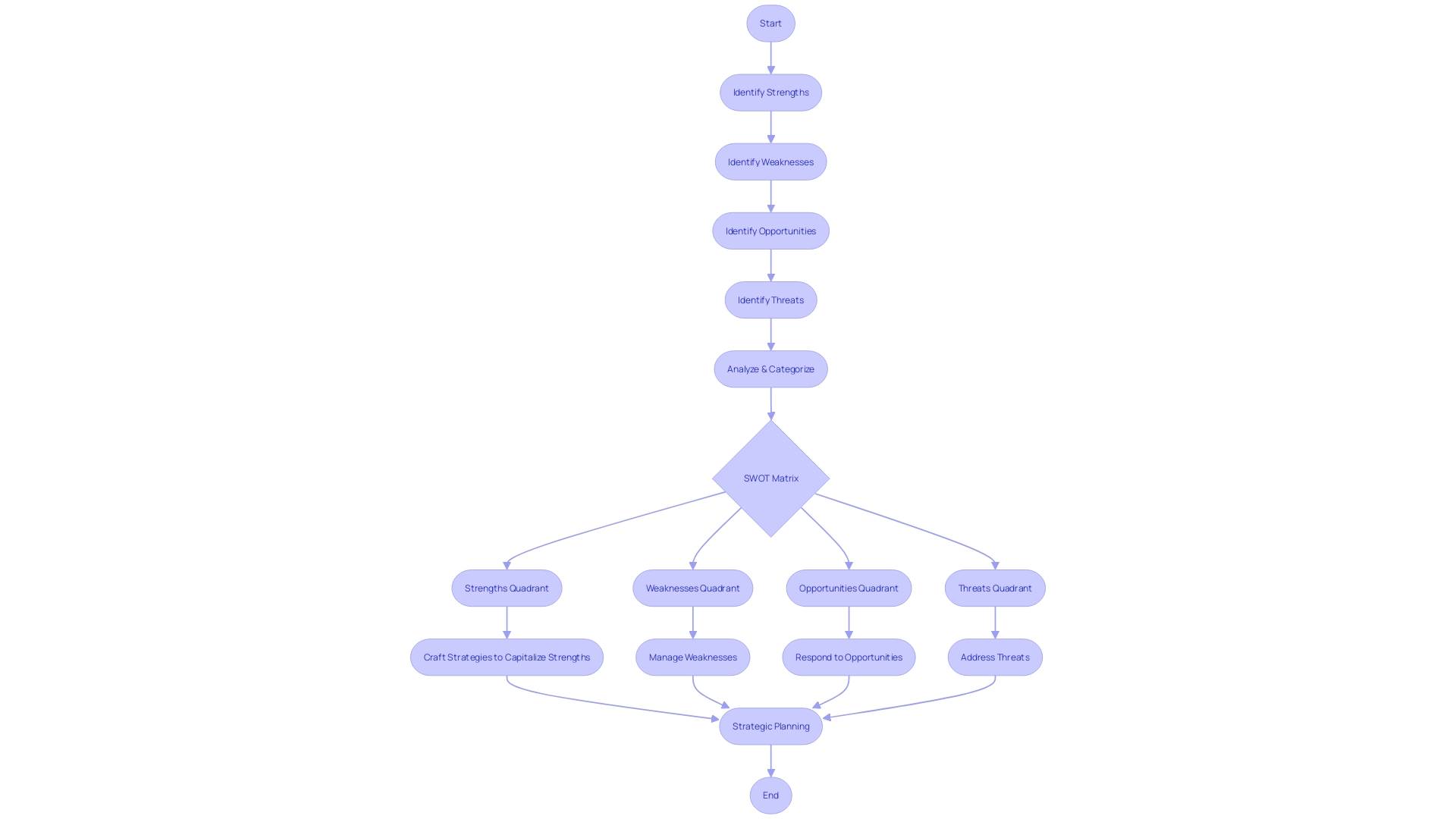
Practical Examples of SWOT Analysis
Delving into the practical application of SWOT Analysis, let's examine its implementation within different organizational contexts. A poignant example can be found in M&T Bank, a significant player in the financial sector with a storied history and extensive workforce. The bank stood at a crossroads faced with the digital revolution, which demanded a swift and secure transition to protect sensitive data amidst the rising tide of technological innovation and regulatory scrutiny.
The bank's leadership undertook a SWOT Analysis focusing on establishing Clean Code standards across the organization, which was instrumental in enhancing software maintainability and performance.
Another case is a startup where SWOT Analysis is not just a tool but a vital part of the strategic planning process. It provides a comprehensive view of the business landscape, identifying potential regulatory hurdles and competitive challenges, thereby laying the groundwork for robust decision-making and clear strategic direction.
In the hospitality industry, a renowned hotel capitalized on its prime location to boost Food & Beverage (F&B) sales by undertaking a SWOT Analysis. The strategic move identified leveraging location as a pivotal strength and crafted a plan to refurbish its restaurant, resulting in impressive reviews and a surge in sales.
Nets, a European digital payment solutions provider, faced the challenge of presenting technical data in an accessible format. Through SWOT Analysis, they identified their strengths in their ability to innovate in data presentation, which led to improved onboarding processes and noticeable results.
These examples illustrate the versatility and efficacy of SWOT Analysis across different industries and scenarios, demonstrating its role in shaping strategies that exploit organizational strengths, address weaknesses, capitalize on opportunities, and guard against threats.
Case Study: SWOT Analysis of a Tech Startup
A tech startup's journey to success is often paved with strategic evaluations using tools like SWOT analysis. Let's delve into a case where a nascent online marketplace for independent designers utilized SWOT analysis to navigate the complex world of e-commerce. Initially, the founders faced the challenge of generating demand.
They sparked initial sales by purchasing items from designers and managing the sales themselves, which introduced them to the intricate dynamics of shipping and inventory management.
By employing the SWOT framework, the startup was able to dissect its internal landscape and external environment. They identified their strengths, which included a high-performing team, innovative marketing approaches, and a burgeoning loyal customer base. These attributes, akin to a strong and well-defined brand, served as their competitive edge.
The analysis brought to light weaknesses and vulnerabilities within their operations, which could potentially put them at a disadvantage in the competitive market, such as financial resource constraints or gaps in team dynamics.
The external analysis highlighted opportunities for growth and expansion, while also acknowledging threats from competitors and market volatility. For example, the recent successful IPO of Arm Holdings, valued at $55 billion, underscores the tech industry's rapid growth and the potential for startups to scale. However, it also signals the intense competition and the need to stay innovative in a market that heavily rewards first movers and disruptors.
By understanding these internal and external factors, the startup was positioned to make informed decisions, align their strategic planning with market positions, and take calculated actions. Insights from leaders in the tech industry, like Ronald Binkofski of STX Next, who emphasizes the importance of a calm and balanced approach, served as guiding principles for the startup. They adopted metrics-driven strategies to refine their effectiveness and productivity, which are essential in forging ahead through the complex yet rewarding terrain of tech entrepreneurship.
Ultimately, the SWOT analysis not only equipped the startup with a comprehensive overview of their business landscape but also illuminated areas that required attention and improvement. It was an instrumental step in their strategic planning, positioning them to leverage their strengths, address weaknesses, capitalize on opportunities, and mitigate threats.
Case Study: SWOT Analysis of a Non-Profit Organization
The Ford Foundation, with its mission to combat global inequality, faced an operational challenge. The foundation's website was initially tailored for low content turnover, managed by a single content producer. As the organization's output surged to several pieces weekly, this once sufficient system became a bottleneck, necessitating a strategic overhaul.
A SWOT analysis was instrumental in this transition, revealing strengths like the foundation's commitment to social change and opportunities to enhance digital engagement. Similarly, non-profit Battelle leverages its expertise in science and engineering to address societal challenges, reinvesting proceeds in STEM education. Their SWOT analysis underscores their innovation as a strength and the need to adapt to market changes as a vital consideration.
These examples illustrate the dynamic application of SWOT analysis within non-profits, guiding them to optimize operations and expand their impact effectively.
Using SWOT Analysis for Strategic Decision-Making
Harnessing the insights from a SWOT analysis is imperative for shaping the future direction of a company. This analytical framework dissects an organization's internal strengths, such as its proficient workforce, solid financial foundation, or cutting-edge technology, and weaknesses that may include financial constraints or cultural vulnerabilities. Additionally, it scrutinizes external opportunities and potential threats, like evolving regulatory landscapes or market competition, that could influence the company's trajectory.
By integrating SWOT analysis into strategic planning, companies delineate clear strategies that leverage their unique strengths and address inherent weaknesses. This process is instrumental in strategic decision-making, where it serves as a guide for resource allocation and goal-setting, ensuring that a company's objectives are aligned with its capabilities and market conditions.
For instance, a SWOT analysis could reveal that an organization's robust professional network is an untapped strength that could facilitate strategic alliances and expansion into new markets. Conversely, the recognition of insufficient financial resources as a weakness prompts proactive measures to fortify financial stability.
Moreover, the analysis aids businesses in preempting future challenges by identifying potential threats, such as competitive pressures, and crafting preemptive strategies to mitigate their impact. The structured approach of SWOT analysis ensures that businesses can navigate their path with confidence, making informed decisions that contribute to a smooth launch and sustainable growth.
In summary, SWOT analysis is not merely an evaluative tool but a strategic compass that directs businesses towards optimal operational health and market positioning, ultimately fostering informed decision-making and effective strategy formation.
Tips and Best Practices for Effective SWOT Analysis
Harnessing the full potential of a SWOT analysis requires a methodical approach to assess and interpret the data accurately. Initially, consider your company's unique selling points—what distinguishes your business within the industry? These strengths might include a dedicated workforce, robust financial reserves, or advanced technology.
Conversely, recognizing internal weaknesses is just as critical. This could involve identifying areas like financial constraints within certain departments or potential vulnerabilities in team dynamics.
Moving outward, opportunities in the external environment await exploitation. Market research is invaluable here, providing insights into customer demographics and helping to pinpoint unmet demands. Furthermore, stay vigilant about external threats that could impact your business, such as regulatory shifts or increased competition.
These factors are beyond your control but understanding them can aid in crafting a resilient strategy.
Ultimately, a SWOT analysis is not just an evaluative exercise; it's a strategic foundation that informs decision-making and shapes the future trajectory of your business. By conscientiously applying the insights gained from your SWOT analysis, you can develop targeted strategies that leverage strengths, address weaknesses, seize opportunities, and mitigate threats—positioning your company for success in its competitive landscape.
Common Mistakes to Avoid in SWOT Analysis
While the SWOT analysis offers invaluable insights into an organization's strategic position, common missteps can undermine its effectiveness. To harness its full potential, it's critical to sidestep these pitfalls. For instance, Toyota's Woven Planet initiative faltered not due to a lack of vision, but because of execution challenges and misaligned ambitions with concrete deliverables.
The project aimed to create software that would set industry standards, yet it stumbled due to overly ambitious software goals and deadlines that didn't align with the company's needs for ready-to-deploy car features. This underscores the importance of aligning a SWOT analysis with realistic objectives and timelines.
A SWOT analysis should encompass an honest appraisal of internal strengths such as a company's financial health or technological prowess, while also considering external threats beyond your control, like market volatility or regulatory changes. For example, potential threats could range from a global pandemic to rising material costs, and these factors need to be factored into a thorough SWOT analysis. Properly executed, SWOT can guide strategic decisions, helping businesses to capitalize on their unique advantages and navigate their industry landscape more effectively.
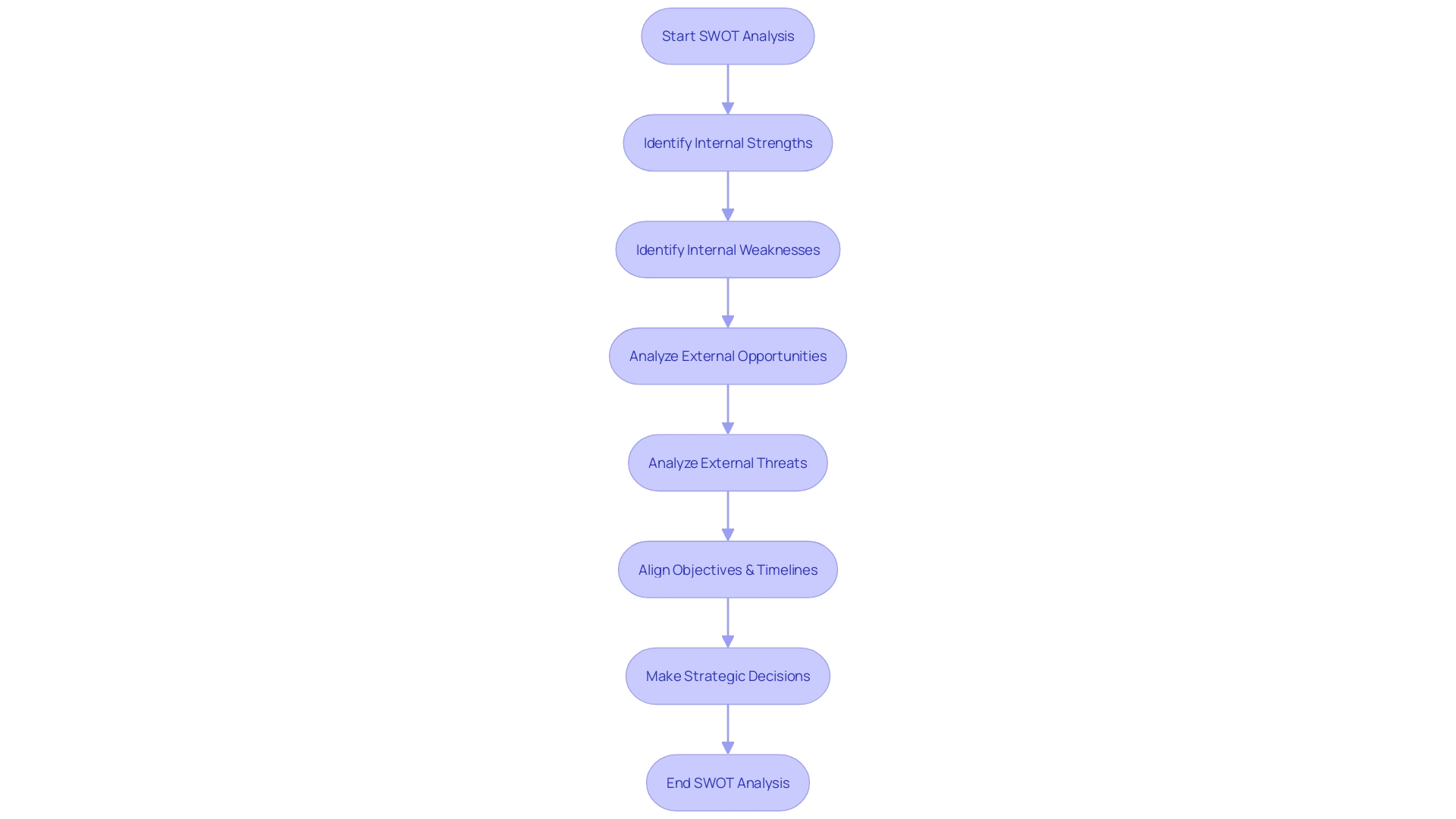
Conclusion
A SWOT analysis is a powerful tool for businesses of all sizes, providing a comprehensive assessment of internal strengths, weaknesses, external opportunities, and threats. By leveraging strengths, addressing weaknesses, seizing opportunities, and mitigating threats, businesses can make informed decisions and develop effective strategies.
The components of a SWOT analysis involve evaluating internal strengths, such as skilled personnel and robust financial health, and weaknesses that require improvement. It also includes identifying external opportunities for growth and improved performance, as well as threats that could hinder success.
To conduct an effective SWOT analysis, businesses must collect and scrutinize relevant data, understand the business environment, and document findings in a structured manner. This analysis aids in strategy formulation, goal-setting, and resource allocation, ensuring alignment between objectives and capabilities.
By adopting a methodical approach, considering unique selling points, identifying weaknesses, exploring external opportunities, and recognizing threats, businesses can maximize the benefits of a SWOT analysis. Market research and staying informed about industry trends are crucial. It's important to avoid common mistakes, such as setting unrealistic objectives or overlooking external threats beyond one's control.
In conclusion, a SWOT analysis serves as a strategic compass, providing businesses with insights to navigate their competitive landscape. By leveraging strengths, addressing weaknesses, seizing opportunities, and mitigating threats, businesses can make informed decisions, develop effective strategies, and position themselves for success.




